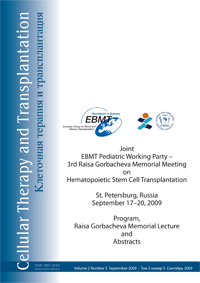Index granularity of neutrophils in peripheral blood as a new application for screening myelodysplastic syndromes using flow cytometry
Ekaterina B. Rusanova1, Konstantin U. Slobodnyuk1, Margarita V.Gorchakova1, Yekaterina E. Zueva1, Ramon Simon-Lopez2
1Department of Clinical Laboratory Diagnostics, Center for Laboratory Diagnostics, St. Petersburg Pavlov State Medical University,
St. Petersburg, Russia; 2Ramon Simon-Lopez, Beckman Coulter, Nyon, Switzerland
Correspondence
Ekaterina B. Rusanova, Department of Clinical Laboratory Diagnostics, Center for Laboratory Diagnostics, St. Petersburg Pavlov State Medical University, 6/8, Tolstoy str., St. Petersburg, 199044, Russia
Phone/Fax: +7 (812) 233 9726, E-mail: katerina.rusanova@gmail.com
Summary
Purpose
Myelodysplastic syndrome (MDS) is a group of clonal bone marrow disorders. The list of features used commonly for diagnosis of MDS includes several morphological cell characteristics, such as the presence of hypogranulation in the neutrophils. We have observed in our daily experience that the NE Mean scatter (SS) was lower in MDS than in normal cases and the scatter of lymphocyte SS is quite constant in normal cases and in the majority of MDS.
Methods
Twenty-four diagnosed with MDS and 16 normal blood donors as a control group were enrolled into this study. The protocol of study included evaluation of blood cell populations with the GenS (BC) hematological analyzer, smears microscopy, and flow cytometry for identifying neutrophils granularity levels (FC500, BC). We created a single tube protocol for immunophenotyping of blood cells with multiparametric flow cytometry using a panel of monoclonal antibodies: CD14-FITC, CD16-PE, CD33-PC5, and CD45-PC7 (BC). In order to standardize the NE mean SS we also used an index granularity of neutrophils (IGN), which was calculated by dividing the neutrophil mean SS by lymphocyte mean SS.
Results
The results show that IGN was significantly lower in MDS than in the normal group (p<0.001). We obtained AUC=0.874 (significance level 0.0001) with a cut-off of <=8.34, a sensitivity of 87.5% with a specificity of 81.5% using the IGN to detect MDS.
Conclusions
The information about hypogranularity of the neutrophils is a well-known feature of MDS. Using IGN may be a useful tool to detect or flag neutrophil hypogranularity and could facilitate the differential diagnosis of MDS.
Keywords
myelodysplastic syndrome, dysplasia, hypogranularity, flow cytometry, screening, peripheral blood


